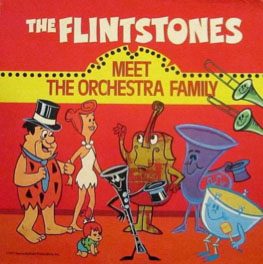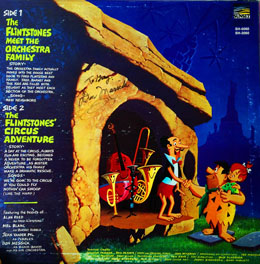A full orchestra moves into Bedrock, Pebbles and Bamm-Bamm go all “balloon boy” and Hanna-Barbera records head into the Sunset of the ‘60s.

Hanna-Barbera Presents
THE FLINTSTONES MEET THE ORCHESTRA FAMILY
Sunset (Liberty) SH-6060 (Stereo) SH-2060 (Mono) (12” 33 1/3 RPM LP / 1968) Reissue: Columbia Special Products P-13909 (Mono) (12” 33 1/3 RPM LP / 1977 / Also on cassette tape)
Executive Producer: Paul DeKorte. Writer: John McCarthy. Arranger/Conductor: Ted Nichols. Technical Producer: Tony Milch. Engineer: Phil Kaye. Art Director: Bob Schaefer. Front Cover Art: Jerry Eisenberg, Paul Julian. Back Cover Art: Jerry Eisenberg, Gary Niblett. Running Time: 30 minutes.
Voices: Alan Reed (Fred Flintstone); Mel Blanc (Barney Rubble); Jean Vander Pyl (Pebbles); Don Messick (Bamm-Bamm, Mr. Orchestra); Henry Corden (Fred Flintstone Singing Voice); Rebecca and Ricky Page (Pebbles and Bamm-Bamm Singing Voices).
Songs: “New Neighbors,” “We’re Going to the Circus,” “Nothin’ Can Swoop (Like the Harp),” “If You Could Fly” and an untitled instrumental by John McCarthy.
A typical Flintstone record might be a collection of songs with bridging dialogue (Golden’s Songs of The Flintstones, Rhino’s Christmas in Bedrock); stories with or without the theme song (Colpix TV soundtrack, Peter Pan’s two Flintstone albums); or the “HBR” Cartoon Series format with stories interrupted by disparate songs.
But as a “book” musical in which the characters speak and also break into songs that serve the story, The Flintstones Meet the Orchestra Family is unique. Perhaps puzzlingly so, because there seems to be no apparent reason why such a lavish, fully orchestrated extravaganza was undertaken at all. True, this album was released along with the other H-B Sunset record, Shazzan and the Evil Jester of Masira, with a similar, if not quite as high, level of opulence, but Orchestra Family is downright spectacular. Maybe the record deal with Liberty included a few extra production dollars.No other Hanna-Barbera made-for-records production has as large an orchestra (Jack and the Beanstalk and Hey There, It’s Yogi Bear are more soundtracks). It is likely the score was recorded in Europe, as was the case with a lot of recordings of the period, but it’s still impressive, and perfectly suited to the album’s theme of music appreciation.
The Orchestra family is a group of anthropomorphic instruments with a human cartoon conductor that move into Bedrock. On side one, each is introduced singularly or in sections (cleverly explained as being in separate rooms of the house). They play a simple melody that is not given a title, though it could be called “Good Morning, Mr. Flintstone” or just “The Orchestra Family Song.” Side two, “The Flintstones’ Circus Adventure,” finds Fred, Barney, Pebbles, Bamm-Bamm and the Orchestra Family going to the circus, where the children must be rescued after flying dangerously above the circus grounds with helium balloons.
Despite the grandeur of the production, this album does not have the snappy, multi-level writing so often delivered by Charles Shows on the HBR series. Script and songwriter John McCarthy—scribe of several songs for the H-B feature, The Man Called Flintstone, aimed the Orchestra Family LP squarely at the very young.
The script makes Fred and Barney out to be chipper and cheerful (except when danger threatens), much as they became in many later Flintstone cartoons (at one point near the end of side one, when the group is all mumbling niceties, Alan Reed’s last “hah-huh” chuckle is particularly odd). Jean Vander Pyl seems underutilized as Pebbles, when it would have been nice to give Wilma a few lines (Betty could be out of town to save money on the album).
 Perhaps this was a conscious choice, as this album (and the Shazzan one) were obviously produced after the HBR label folded. Studio music supervisor Paul DeKorte was using a different approach perhaps because the earlier albums had not caught fire and Liberty had stepped in. Liberty had a stronger distribution reach and seems to have taken the remaining HBR records into their stock (a crack-and-peel black Sunset Records sticker was placed on top of the shrinkwrap over the HBR logo).
Perhaps this was a conscious choice, as this album (and the Shazzan one) were obviously produced after the HBR label folded. Studio music supervisor Paul DeKorte was using a different approach perhaps because the earlier albums had not caught fire and Liberty had stepped in. Liberty had a stronger distribution reach and seems to have taken the remaining HBR records into their stock (a crack-and-peel black Sunset Records sticker was placed on top of the shrinkwrap over the HBR logo).
It would be interesting to speculate what might have transpired if the H-B/Liberty association had continued, since the production values were ramped up. But entertainment tastes were changing; children’s records were being increasingly usurped by kids’ purchase of pop records. This was the age of The Monkees and The Archies, as well as other forms of pop claiming the allowances of youngsters.
Despite the somewhat saccharine taste, The Flintstones Meet the Orchestra Family makes for some fine H-B listening. It sounds great and the songs are done in what I call “Jetson Jazz,” with that big, brassy Hanna-Barbera “Rock Vegas” sound. Too bad Columbia Special Products chose to reissue the mono version, but then a lot of things could have been better about the Columbia reissues despite the higher quality vinyl.
Applause and huzzahs are also due to Paul Julian and Gary Niblett for their work on the front and back cover art—and especially to Jerry Eisenberg who worked on both. The artwork and the orchestrations (and the original voice cast) make this album—as Rita Wedemeyer said about Ralph Kramden—“a tray-sure.”
GIVE A LITTLE LISTEN
“If You Could Fly” & Untitled Instrumental
“If You Could Fly” is the LP’s big production number, served up in the grandest Jet Screamer/Miss Western Hemisphere tradition by musical director Ted Nichols, with Rebecca and Ricky Page as Pebbles and Bamm-Bamm. The attached instrumental has a “production library music” sound with an ending that would have been great for one of those ‘60s “coming attractions” theatrical film loops.



 GREG EHRBAR is a freelance writer/producer for television, advertising, books, theme parks and stage. Greg has worked on content for such studios as Disney, Warner and Universal, with some of Hollywood’s biggest stars. His numerous books include Mouse Tracks: The Story of Walt Disney Records (with Tim Hollis). Visit
GREG EHRBAR is a freelance writer/producer for television, advertising, books, theme parks and stage. Greg has worked on content for such studios as Disney, Warner and Universal, with some of Hollywood’s biggest stars. His numerous books include Mouse Tracks: The Story of Walt Disney Records (with Tim Hollis). Visit 





















































Just listening to that track you highlighted, I could tell I would’ve LOVED playing the heck out of this as a kid had I had this LP at all.
Greg:
Another interesting post! The “If You Could Fly” number was unusually good,the untitled instruemental was really good! (I’m a production music fan) Thanks for sharing!
What makes this album especially noteworthy is the fact that all of the voices are authentic–Alan Reed as Fred with Henry Corden doing the singing voice, Mel Blanc as Barney, Jean Van der Pyl as Pebbles, and Don Messick as Bamm-Bamm. Messick’s performance as the Orchestra Leader makes him sound like another genuine Hanna-Barbera character. But I do wonder why, if Messick could double as Bamm-Bamm and Mr. Orchestra, then why couldn’t Jean have played Wilma on the album as well as Pebbles?
Most of the record albums present Fred and Barney essentially as bachelors, with the absence of the wives only minimally explained if at all. A similar dynamic existed in the late 70’s with “The New Fred and Barney Show,” which rarely included Wilma and Betty in the main body of an episode. They were featured in the beginning and at the end, but only a couple of times did they participate in the main adventure. Maybe it was thought that kids could relate better to best friends interacting than husbands and wives.
There are some bizarre aspects to this album, beyond the fact that the characters frequently burst into song. It’s taken for granted that the instruments are living, sentient beings, and that their music is “solid” enough for a person to ride into the sky on it. It does provide a clever resolution to the balloon dilemma, but it’s a real stretch of the imagination, even for a kid.
Side A is less of a story and more of a lesson in the instruments of the orchestra. Side B sounds more like a genuine Flintstones episode–one with songs to supplement the dialogue–not unheard-of in the series, as there were a few musical episodes, such as the one featuring Ann-Margrock and the Christmas episode.
I agree that it is puzzling as to why so much money was lavished on this album when it’s basically a one-off deal. But it’s definitely a gem.
It has a satisfying closing line–“We’ll let the kids hold onto the balloons, but we’ll hold onto the kids!”
Most of the record albums present Fred and Barney essentially as bachelors, with the absence of the wives only minimally explained if at all. A similar dynamic existed in the late 70′s with “The New Fred and Barney Show,” which rarely included Wilma and Betty in the main body of an episode. They were featured in the beginning and at the end, but only a couple of times did they participate in the main adventure. Maybe it was thought that kids could relate better to best friends interacting than husbands and wives.
Wouldn’t surprise me. I recall the crappy Peter Pan Read-Along records as a kid that went the same route too.
https://www.youtube.com/watch?v=vIVtxz7IFq4
I agree that it is puzzling as to why so much money was lavished on this album when it’s basically a one-off deal. But it’s definitely a gem.
Could you imagine Gravity Falls or Spongebob Squarepants getting that kind of treatment? It would be nice!
Liberty Records itself was about to head off into “that 60’s sunset” not long afterward; they were gobbled up by Transamerica, an insurance and finance conglomerate with an itch for show biz. Transamerica had already taken over United Artists Pictures and its record label; Liberty was simply folded into UA around 1970. The Liberty name was temporarily revived for a time in the mid-80’s, as UA sold their combined record operations to Capitol (which, with its parent company EMI, was recently devoured by Universal…ye gads…)
I can recall Sunset stickers also being placed over Liberty’s own logo on budget reissues of David Seville’s Chipmunks and other LPS, as a way to use up remaindered album jackets. (Al-bum! Okay!!) Original Sunset LPS were a budget-price line similar to RCA’s Camden, pressed on styrene rather than vinyl, but still quite good quality; better than Pickwick or Springboard.